Natural biomolecules derived from renewable sources, including chitosan, appear to be promising choices for biodegradable food packaging innovation. Chitosan is a linear polymer made from Chitin that has been alkaline deacetylated. This biopolymer is made from the exoskeletons of crustaceans, which are obtained from industrial seafood wastes. As considered in the journal Materials, Chitosan is a multifunctional biomolecule that may be found in a variety of foods and pharmaceuticals.
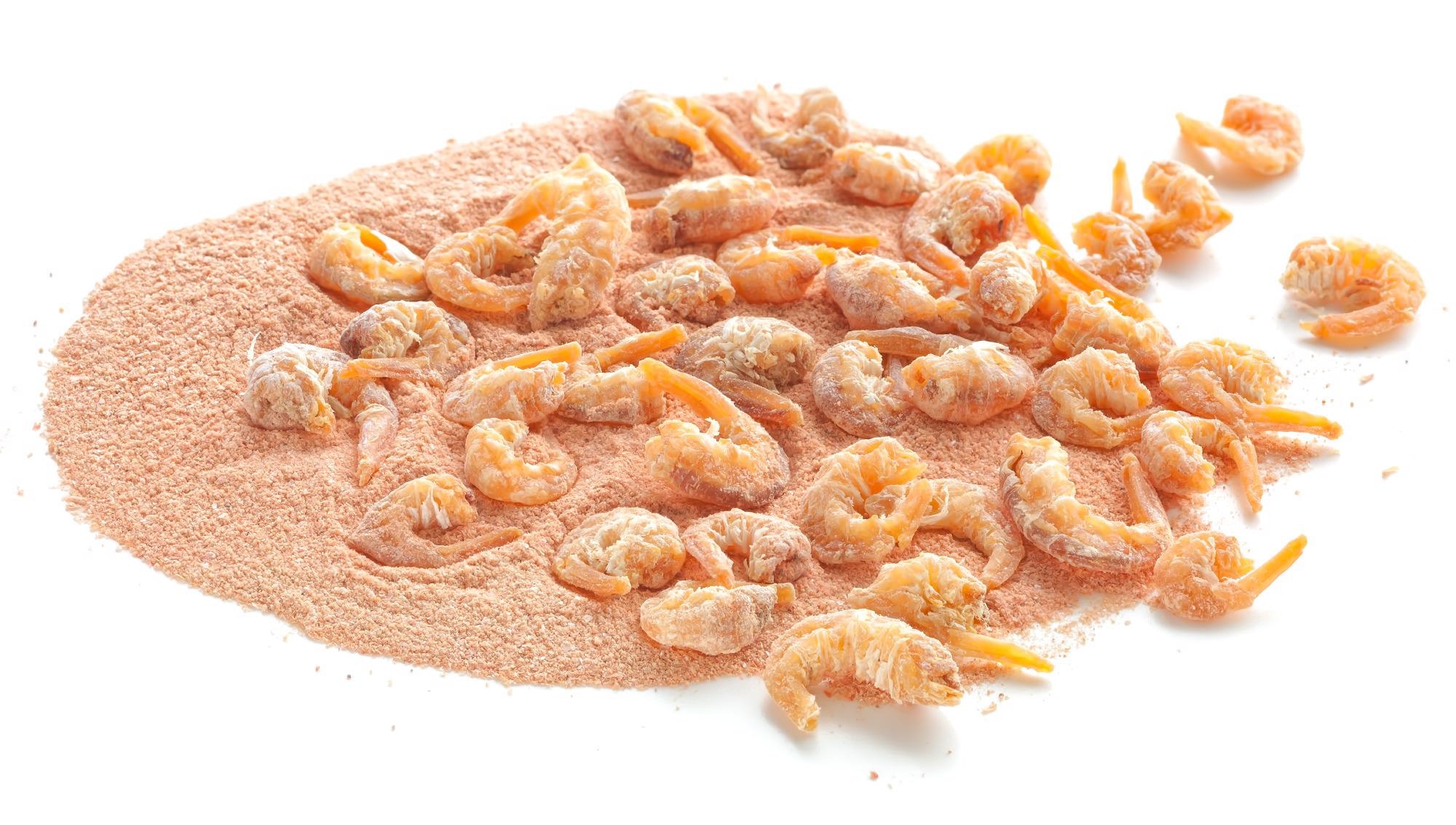
Review Study: Chitosan as a Valuable Biomolecule from Seafood Industry Waste in the Design of Green Food Packaging. Image Credit: EvergreenPlanet / Shutterstock
Chitin may be deactivated in an alkaline environment in order to obtain and utilize it. This biomolecule may be recovered from seafood industry waste, such as shrimp shells, using traditional or green processes. Additionally, biological features like antibacterial and antioxidant capabilities, along with biocompatibility, biodegradability, and nontoxicity, have aided its growing use as active food packaging.
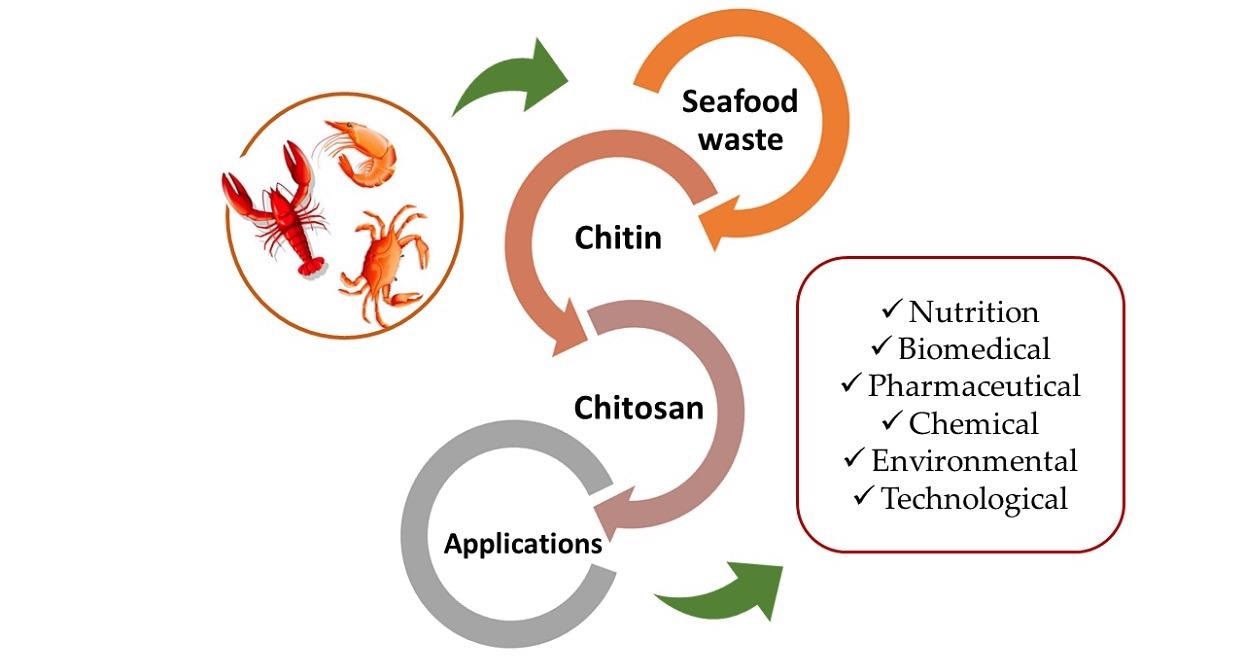
Calcium carbonate, proteins, pigments, Chitin, and lipids make up the biomass of crustaceans.
By combining mechanical or chemical treatments, the extraction method yields close to 20%–30% chitin.
Traditional alkali treatments of crustacean biomass to create Chitin and chitosan can be inefficient and may be deemed unfavorable in terms of the environment and labor conditions. On the other hand, green solvents can be utilized to replace conventional techniques and increase chitin extraction and chemical modification operations efficiency.
The extensive expansion of the aquaculture business, which includes crustaceans, fish, mollusks, and other organisms, is linked to rising fish consumption rates, which is one of the most traded foods.
On the other hand, the fish business has faced several obstacles, most of which are connected to its ecological sustainability. Because a large quantity of trash is generated during seafood processing, extracting Chitin from this residue is a viable way to add value to the market while also reducing pollution.
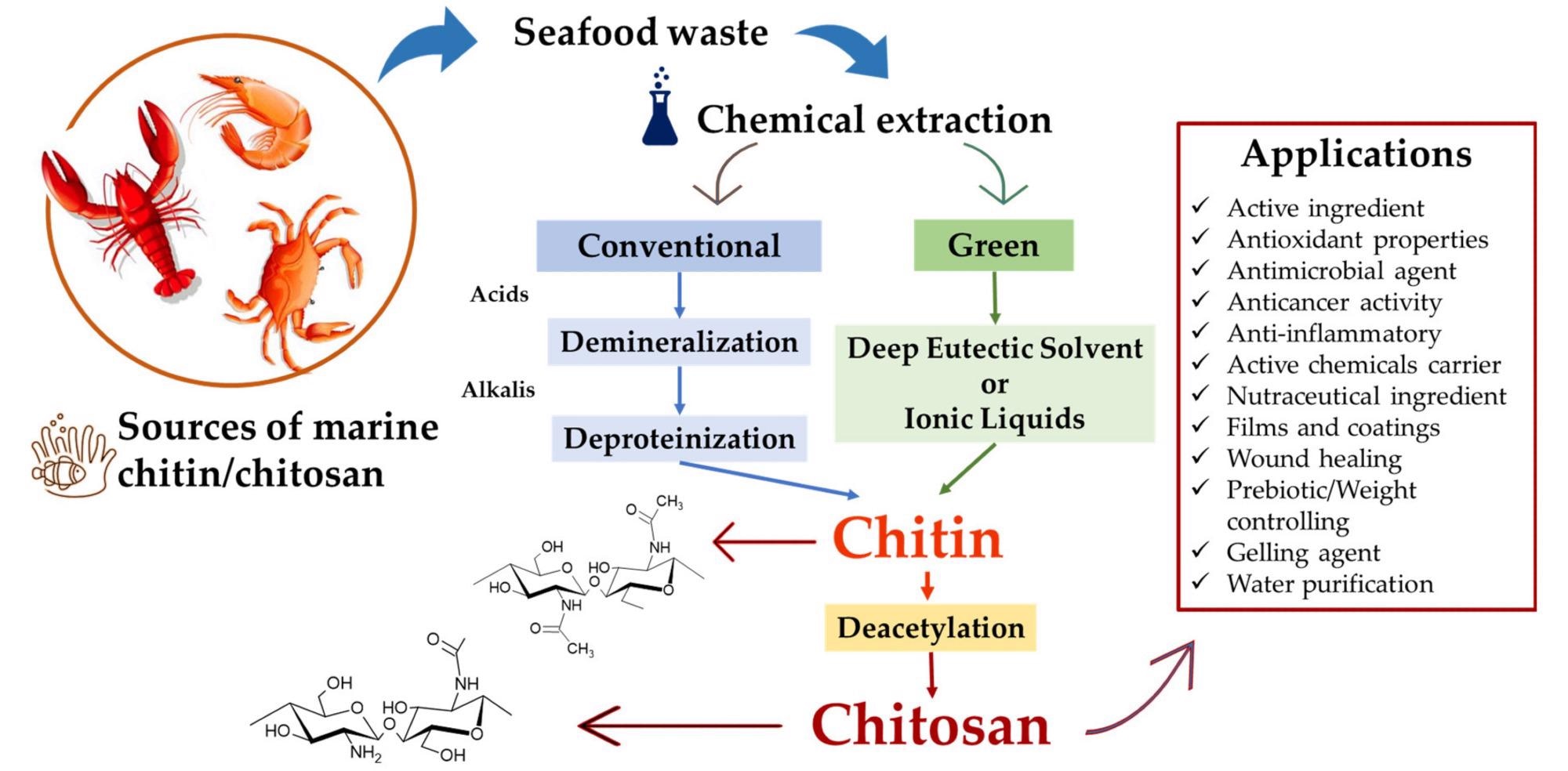
Summary of chitin/chitosan extractions and application. Image Credit: Costa, B et al., Materials
Chitosan Green Solvent Processing
On the other hand, Chitin is an underused biomass resource that is primarily employed in the chemical manufacture of chitosan. Due to its strong intramolecular and intermolecular hydrogen bonding, Chitin is insoluble in most inorganic and organic solvents.
It is necessary to dissolve it in order to calculate the molecular weight. Meanwhile, because particulates in chitin dispersion exist, light scattering measurements are tricked, and molecular weight cannot be determined. For chitin solubilization, green solvents such as deep eutectic solvents and ionic liquids, such as 1-allyl-3-methylimidazolium bromide, and several others, have lately been utilized.
The pharmaceuticals, cosmetics, dietary, and food industries are the most important markets for chitosan, owing to its categorization as a safe material by regulatory bodies in many countries. In food and nutrition, chitosan or CS has a substantial market in Asia, particularly China, Japan, and South Korea, as well as the United States of America and Europe, with over 2000 metric tons sold in 2018.
This demand stems mainly from the use of CS as a functional component in nutritional supplements and as an organic food additive with various activities.
Various research has established the numerous biological properties of chitosan, including antioxidant, antibacterial, anti-inflammatory, antifungal, wound healing, prebiotic effects, and immunostimulant. Furthermore, it has been suggested that CS may enhance the excretion of atherogenic saturated fatty acids, thereby lowering the chance of developing a chronic disease.
Chitosan is one of the most researched polysaccharides in the production of packaging films and coatings. This is due to its flexibility and its excellent chemical, physical, and biological characteristics. The chitosan pH, solvent, DA, viscosity, concentration, and molecular weight all determine its mechanical characteristics.
Furthermore, as compared to other biopolymers, chitosan is often less costly and more widely available. Edible films and coatings must safeguard food integrity, ensure quality, reduce mass and volatile losses, increase shelf life, avoid surface contamination, provide mechanical protection, and improve sensory characteristics, much like every other packaging.
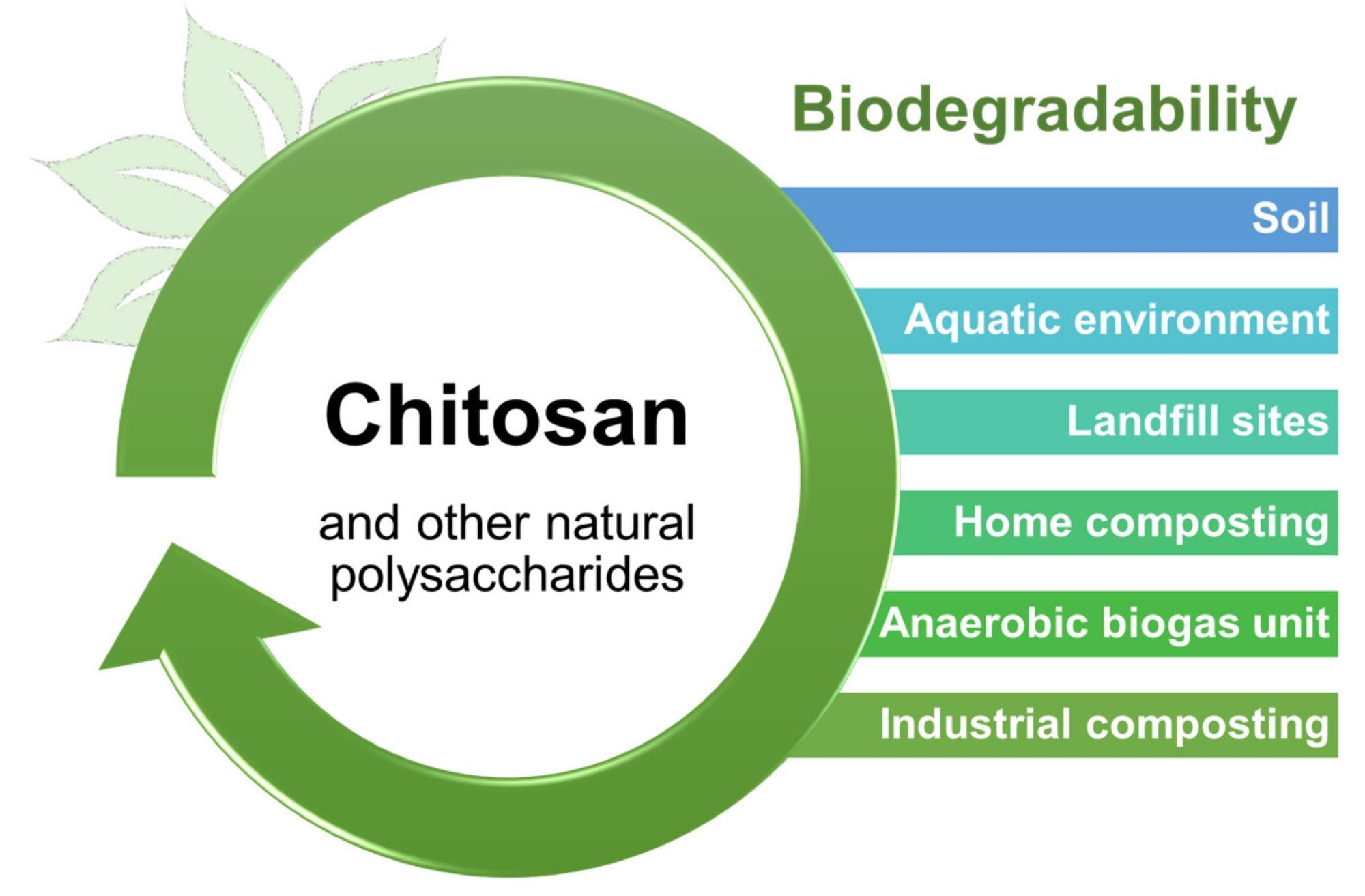
Biodegradability of chitosan and other natural polymers and in various environments. Image Credit: Costa, B et al., Materials
Chitosan is Biodegradable
While edible films are unlikely to replace all traditional packaging, they may be used to reduce the usage of petroleum-based plastics significantly, minimize food waste, and cut emissions in the long run. Two primary basis materials, biomacromolecule-based matrices, and additives, such as cross-linkers, plasticizers, various reinforcing compounds, and functional components, may be present in edible films and coatings.
These substances can be used separately or in combination. Edible packaging may be defined as a subcategory of biodegradable and biobased packaging since it is made of natural-based substances.
Microorganisms may destroy chitosan-based films, making them environmentally benign. Compared to polypropylene films, which can reduce environmental pollution caused mainly by the food packaging sector, green chitosan-based films' most significant beneficial impact is connected to end-of-life situations, associated explicitly with decomposition and carcinogens.
Another issue may arise, such as water molecules being an issue for the period of storage and the physical stability of the packaging. Thus the hydrophilic nature of their biological macromolecules matrix should be addressed while developing biobased films.
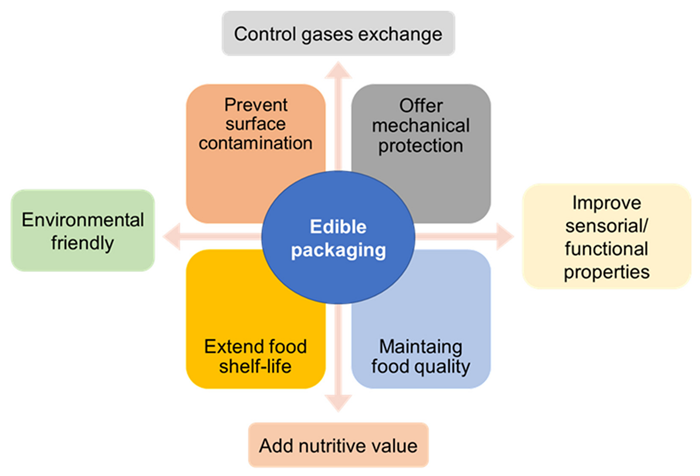
Primary purposes of edible food packaging. Image Credit: Costa, B et al., Materials
References
Costa, B., and Andrade, C. (2021). Chitosan as a Valuable Biomolecule from Seafood Industry Waste in the Design of Green Food Packaging. Biomolecules and Materials from Agro-Industrial Wastes. Published Online: 28 October 2021. https://www.mdpi.com/2218-273X/11/11/1599
Disclaimer: The views expressed here are those of the author expressed in their private capacity and do not necessarily represent the views of AZoM.com Limited T/A AZoNetwork the owner and operator of this website. This disclaimer forms part of the Terms and conditions of use of this website.